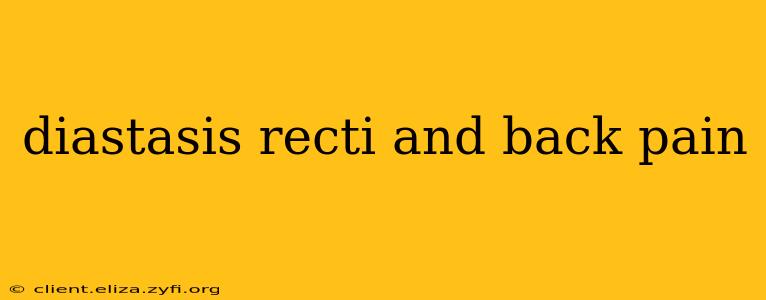Diastasis recti, the separation of the abdominal muscles, often gets associated with postpartum recovery. However, it can also contribute to back pain, impacting individuals beyond new mothers. This comprehensive guide explores the relationship between diastasis recti and back pain, examining causes, symptoms, and effective treatment strategies.
What is Diastasis Recti?
Diastasis recti refers to the widening of the linea alba, the connective tissue that runs down the midline of your abdomen, separating your right and left rectus abdominis muscles (the "six-pack" muscles). This separation can occur during pregnancy due to the growing uterus stretching the abdominal wall. However, it can also affect individuals who are not pregnant, particularly those with weakened core muscles or those who engage in activities that put excessive strain on the abdominal area.
How Does Diastasis Recti Cause Back Pain?
A significant diastasis recti can disrupt the body's core stability. The abdominal muscles play a vital role in supporting the spine and maintaining proper posture. When these muscles are separated, the core's ability to provide this support diminishes, potentially leading to:
- Increased strain on the back muscles: To compensate for the weakened core, the back muscles often work overtime, leading to muscle fatigue, strain, and pain.
- Altered posture: A weakened core can contribute to poor posture, such as increased lumbar lordosis (the inward curve of the lower back), placing additional stress on the spine.
- Pelvic instability: The connection between the core and pelvic stability is crucial. Diastasis recti can disrupt this connection, contributing to pelvic pain and potentially affecting back pain.
- Increased risk of injury: A weakened core makes you more susceptible to injuries, including back strains and sprains, further exacerbating existing pain.
What are the Symptoms of Diastasis Recti?
Recognizing diastasis recti is crucial for effective management and pain relief. Common symptoms include:
- A visible bulge or separation down the midline of the abdomen: This is particularly noticeable when you perform actions that increase abdominal pressure, such as coughing, laughing, or sitting up.
- Lower back pain: This is often the primary symptom that prompts individuals to seek medical attention.
- Pelvic pain: Pain in the pelvic region can be associated with diastasis recti due to the interconnectedness of the core and pelvic floor muscles.
- Poor posture: Slouching or an exaggerated curve in the lower back are often indicators of core weakness.
- Feeling of instability in the core: Many individuals report feeling a lack of support in their midsection.
Can Diastasis Recti Be Treated?
Yes, diastasis recti can be treated effectively. Treatment options typically involve a combination of approaches:
- Physical therapy: A physical therapist can assess the severity of the diastasis and create a personalized exercise program to strengthen the core muscles and improve posture. This often involves specific techniques to heal the connective tissue.
- Core strengthening exercises: Specific exercises, performed correctly, can gradually bring the abdominal muscles back together. Avoid exercises that increase abdominal pressure until the diastasis is improved. Consult a physical therapist or qualified professional for guidance.
- Postural correction: Improving posture through conscious effort and potentially with the help of a physical therapist can significantly reduce strain on the back.
- Manual therapy: Techniques like osteopathic manipulation or chiropractic adjustments may help to alleviate back pain by addressing spinal alignment and muscle tension.
How Do I Know If My Back Pain Is Caused By Diastasis Recti?
It's crucial to consult a healthcare professional to determine the cause of your back pain. They can perform a physical examination to assess the presence and severity of diastasis recti and rule out other potential causes of back pain. Self-diagnosis is not recommended.
What Exercises Should I Avoid With Diastasis Recti?
Certain exercises can worsen diastasis recti, so it's essential to avoid them until the separation has healed. These commonly include:
- Traditional crunches: These exercises put excessive pressure on the abdominal muscles and can further separate the linea alba.
- Plank variations (especially long holds): While planks are good for core strengthening, incorrect form or prolonged holding can exacerbate the issue.
- Sit-ups: Similar to crunches, these exercises can increase abdominal pressure.
- Heavy weightlifting involving core engagement: Until proper healing and strengthening are achieved, heavy lifting can negatively impact the diastasis.
How Long Does It Take to Heal Diastasis Recti?
Healing time varies depending on the severity of the diastasis and individual factors. With consistent and proper rehabilitation, many individuals see significant improvement within several months. However, complete healing can sometimes take longer.
Are there specific exercises to help with Diastasis Recti and back pain?
Yes. However, it's vital to work with a physical therapist. They can design a personalized program based on your specific condition and needs. Generic exercises found online may be harmful if not performed correctly.
Can I prevent Diastasis Recti?
While pregnancy can predispose you to diastasis recti, some preventative measures can help minimize the risk or lessen its severity:
- Maintain a strong core: Consistent core strengthening exercises before and during pregnancy can help.
- Proper posture: Maintaining good posture throughout the day supports core strength.
- Pelvic floor exercises: Strengthening the pelvic floor muscles aids overall core stability.
By understanding the connection between diastasis recti and back pain and seeking professional guidance, individuals can effectively manage their symptoms and regain core strength, leading to a significant improvement in their overall health and well-being. Remember, seeking advice from a qualified healthcare professional is crucial for accurate diagnosis and personalized treatment.
